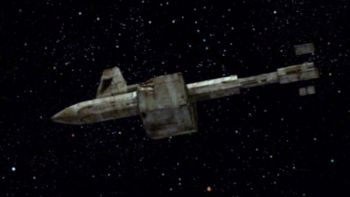Difference between revisions of "DY-100 class"
From Trekipedia
m |
m |
||
| Line 1: | Line 1: | ||
| + | {{ImageBox|imgname=dy100-tos24|caption=DY-100 class ([[Star Trek|TOS]] [[Space Seed (Episode)|24]])}} | ||
==FASA Timeline== | ==FASA Timeline== | ||
| − | |||
The DY-100, introduced in [[FASA Timeline: 1990s#1995|1995]], was the first mass-produced spacecraft capable of routine circumlunar ([[Earth]]-[[Moon (Sol IIIa)|moon]]) travel. Interchangeable modules permitted wide diversity of mission profiles, including an upgrade for interplanetary travel that allowed it to take humans to [[Mars#FASA Timeline|Mars]]. The class remained in service until [[FASA Chronology: 2020s#2020|2020]].<ref name="SFC"/> | The DY-100, introduced in [[FASA Timeline: 1990s#1995|1995]], was the first mass-produced spacecraft capable of routine circumlunar ([[Earth]]-[[Moon (Sol IIIa)|moon]]) travel. Interchangeable modules permitted wide diversity of mission profiles, including an upgrade for interplanetary travel that allowed it to take humans to [[Mars#FASA Timeline|Mars]]. The class remained in service until [[FASA Chronology: 2020s#2020|2020]].<ref name="SFC"/> | ||
| − | |||
| − | |||
| − | |||
| − | |||
| − | |||
<div style="width:25%;float:left;margin-right:0.25em;"> | <div style="width:25%;float:left;margin-right:0.25em;"> | ||
===Specifications=== | ===Specifications=== | ||
| Line 88: | Line 83: | ||
|} | |} | ||
</div> | </div> | ||
| − | + | {{Clear}} | |
| − | + | {{ClassDY100}} | |
| − | + | {{References}} | |
<references> | <references> | ||
| − | <ref name="SFC"> | + | <ref name="SFC">{{RefSFC}}</ref> |
</references> | </references> | ||
| − | |||
[[Category:Library]] | [[Category:Library]] | ||
[[Category:Ships & Vehicles]] | [[Category:Ships & Vehicles]] | ||
| Line 102: | Line 96: | ||
[[Category:VOY]] | [[Category:VOY]] | ||
[[Category:ENT]] | [[Category:ENT]] | ||
| − | |||
[[Category:Film]] | [[Category:Film]] | ||
[[Category:Books]] | [[Category:Books]] | ||
| Line 113: | Line 106: | ||
[[Category:Modiphius]] | [[Category:Modiphius]] | ||
[[Category:Alternate Universes]] | [[Category:Alternate Universes]] | ||
| + | [[Category:Kelvin Timeline]] | ||
Revision as of 11:12, 29 August 2019
FASA Timeline
The DY-100, introduced in 1995, was the first mass-produced spacecraft capable of routine circumlunar (Earth-moon) travel. Interchangeable modules permitted wide diversity of mission profiles, including an upgrade for interplanetary travel that allowed it to take humans to Mars. The class remained in service until 2020.[1]
Specifications
| Length | 100m |
| Beam | 23.37m |
| Draught | 34.9m |
| Mass | 2.72 million kg |
| Living Units/ Fuel Units/ Cargo Units | Interchangeable modules each 27x5.5x6.57m (795m³ usable volume) |
| Engine Section | Combination Chemical/Fission |
| Command Con | 12.3x7.4x4.9m |
| Complement |
|
| Navigation | Optical Tracker-Controlled Inertial Guidance |
| Communications | Laser Radiotelemetry |
| Computer | Standard Program-Dependent Digital Memory |
| Life Support |
|
Performance
| Range (Standard) | 900,000km |
| Range (Maximum) | 387 million km (refitted for duration travel) |
| Velocity (Cruising) | 55,000km/hour |
| Velocity (Maximum) | 80,000km/hour |
| Escape Velocity (Earth) | 38,000km/hour |
| Typical Voyage Duration | 9.2 hours (Earth-Moon) |
| Maximum Voyage (With Supply Stops) | 934 days (Earth-Mars-Asteropolis-Mars-Earth) |
| Thrust (Chemical) | 4.2 million kg
|
| Thrust (Fission) | 68,000 kg (average)
|
DY-100 class vessels
Prime Timeline
Columbia Timeline
LUG Timeline
S.S. Botany Bay DY-109 • S.S. Iberville DY-120 • S.S. Lyons Creek DY-166 • S.S. Monticello DY-158 • S.S. Salisbury DY-131 • S.S. San Juan DY-177 • S.S. Santa Maria DY-164 • S.S. Shenandoah DY-178 • S.S. Wacosta DY-104
FASA Timeline
S.S. Botany Bay • S.S. Copernicus
Kelvin Timeline
Myriad Universes
Notes and References
- ↑ Goldstein, Stan et al (Authors). Spaceflight Chronology. Star Trek. Book. Wallaby Books. 1980.
